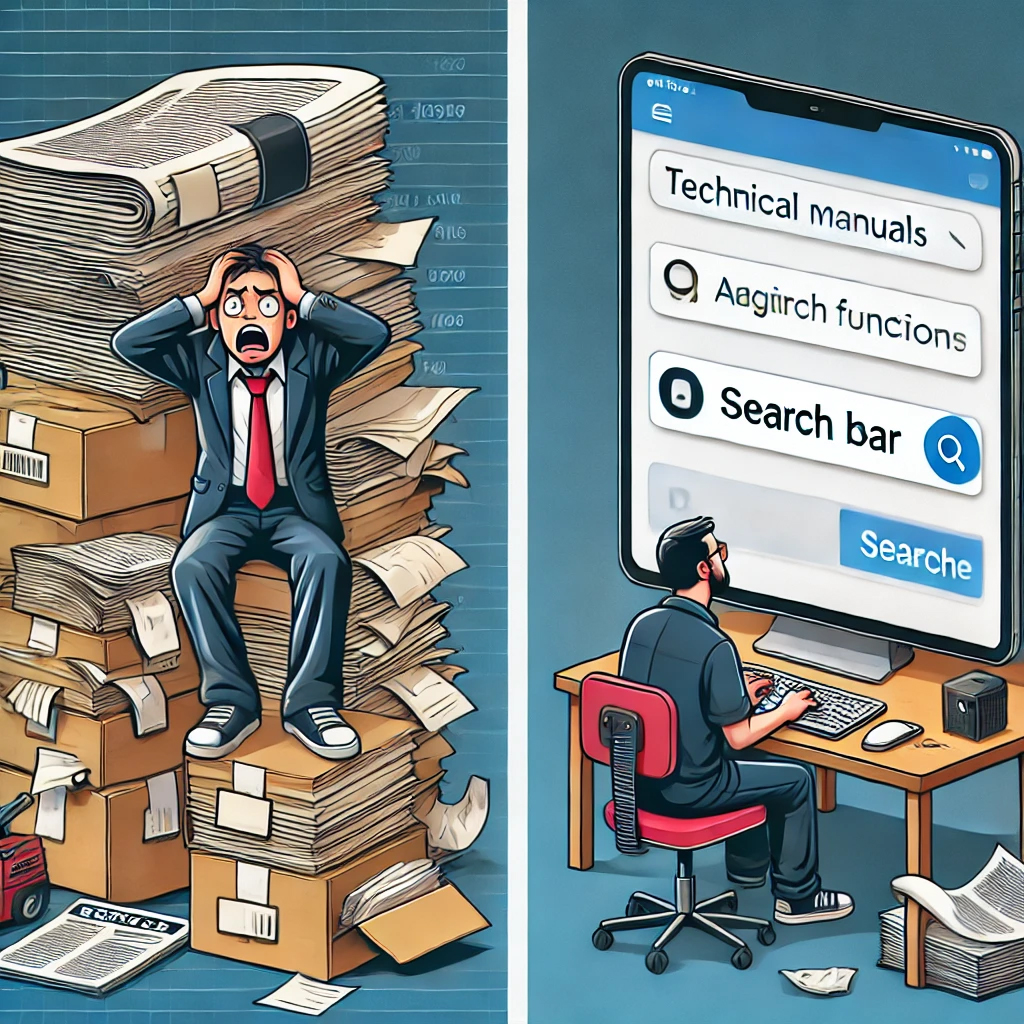A Super Support Technician with Photographic Memory: Fairytale or Reality?

Can AI truly redefine the way professionals interact with technical manuals? I believe so. The vision of transforming traditional static guides into dynamic, intelligent assistants is no longer speculative but an emerging reality revolutionizing the industry.
The Evolution of Technical Manuals
Technical manuals have undergone a significant transformation from their traditional form. Originally bulky and challenging to navigate, these manuals have evolved into digital PDFs equipped with advanced search functionalities and rich visual content. This digital shift represents a major leap forward in improving accessibility and usability, allowing users to find information more efficiently than ever before.
Current Challenges with Technical Manuals
Despite these advancements, technical manuals still present several challenges that can hinder their effectiveness:
- Lack of Interconnected Information: In many cases, useful information is scattered across various documents and not well-integrated. Users often face difficulties connecting related pieces of information, which can lead to incomplete understanding or missed steps.
- Repetitive Content: Manuals frequently contain redundant information spread across multiple volumes. This repetition can create confusion and inefficiency, as users may struggle to determine which section contains the most relevant or up-to-date information.
- Language Barriers: Terminology differences between documents or even within the same manual can create barriers to understanding. Users may encounter different terms for the same component or action, which complicates their ability to quickly locate the correct information.
- Time-Consuming Navigation: Finding precise information in traditional manuals often requires extensive searching and browsing through multiple sections. This time-consuming process can be frustrating and inefficient, particularly when users need quick answers.
How AI Can Transform Documentation
AI has the potential to revolutionize how we interact with technical manuals by addressing the challenges mentioned above:
- Bridging Linguistic Gaps: AI-powered manuals can understand and adapt to variations in terminology. For instance, whether a user refers to a component as a "screw" or a "bolt," or describes an action as "setting up" or "configuring," the AI can interpret these terms and provide accurate, relevant information. This capability ensures that users receive the information they need without having to navigate through complex terminological differences.
- Interactive Assistance: Imagine a manual that functions interactively, responding to user queries in real-time. An AI-enhanced manual could ask clarifying questions, provide context-sensitive guidance, and deliver answers tailored to the user’s specific needs. This dynamic interaction can greatly enhance the user experience and make information retrieval more intuitive.
The Potential Impact of AI-Enhanced Manuals
AI-enhanced manuals could fundamentally change how professionals engage with documentation, offering several key benefits:
- A Super Support Technician: AI-enhanced manuals could function like a super support technician with a photographic memory. They would have the ability to instantly recall and present relevant information from various documents and contexts, effectively eliminating the need for users to manually search through multiple sources.
- Comprehensive and Accurate Information: For professionals, the ability to quickly access comprehensive and accurate information is invaluable. AI-powered tools could streamline workflows, reduce errors, and improve overall efficiency by providing precise answers and guidance without delay.
- Direct Citations: An intelligent manual could provide direct citations linking to the exact sections of the source material that are relevant to the user’s query. This feature would not only enhance the accuracy of the information provided but also make it easier for users to verify and explore the original content, leading to a more robust and reliable documentation process.
Where would I use this?
- Troubleshooting and Maintenance: Technicians could quickly access or search for specific content or troubleshooting steps, reducing downtime and keeping production lines running smoothly. Service technicians and customer support agents could find detailed repair instructions instantly, leading to faster service times and improved customer satisfaction.
- Improved Customer Support: Customer support teams could rapidly find and relay accurate, relevant information to customers, enhancing the support experience and overall satisfaction. Customers would benefit from quicker, more accurate responses to their inquiries, whether related to product setup, troubleshooting, or general questions.
- Efficient and Less Time-Consuming Onboarding/Educational Processes: New employees could easily access training or onboarding manuals and procedural documents, making the onboarding process more efficient. This would reduce the learning curve and decrease my time required for effective onboarding. 😊
- Enhanced Compliance and Safety: In light of recent challenges such as the CrowdStrike security patch issue, an intelligent manual could provide IT professionals with up-to-date safety protocols and procedures, thereby reducing the risk of compliance failures and improving overall security.
Utilize AI to assist with your tasks, but don't rely on it to take over your duties.
- Lack of Data Governance: If you don't know where your relevant data is or if data governance is lacking, intelligent AI-enhanced manuals will be of limited help. As the old saying goes, “Garbage in, garbage out.” Without well-organized repositories of documents, manuals, and internal guidelines, and without proper data governance, AI tools cannot function effectively.
- Validation of Initial Responses: Initial responses from AI need human validation, this won't happen automatically. It's crucial for subject matter experts to review and validate initial outputs to ensure that future responses are accurate and reliable.
- Detailed Questions Are Better: The more specific your question, the more accurate the response will be. Just as with small children or teenagers, if you don’t provide precise context or details, you can’t expect perfect answers from AI right away.
- AI Doesn’t Replace Human Expertise: Recently, I was asked if an AI tool could screen our documentation and create a Business Glossary and KPI list. While AI tools can assist in locating and organizing data (assuming it’s properly organized according to your data governance procedures), they do not replace the need for human expertise. If you use AI to help create a Business Glossary or KPI list, remember that the responsibility for finalizing these documents lies with you, the subject matter expert. Use AI to support your work, but don’t delegate your responsibilities to it. AI can help identify relevant data and streamline the process, but the final product still requires your expertise and approval.




